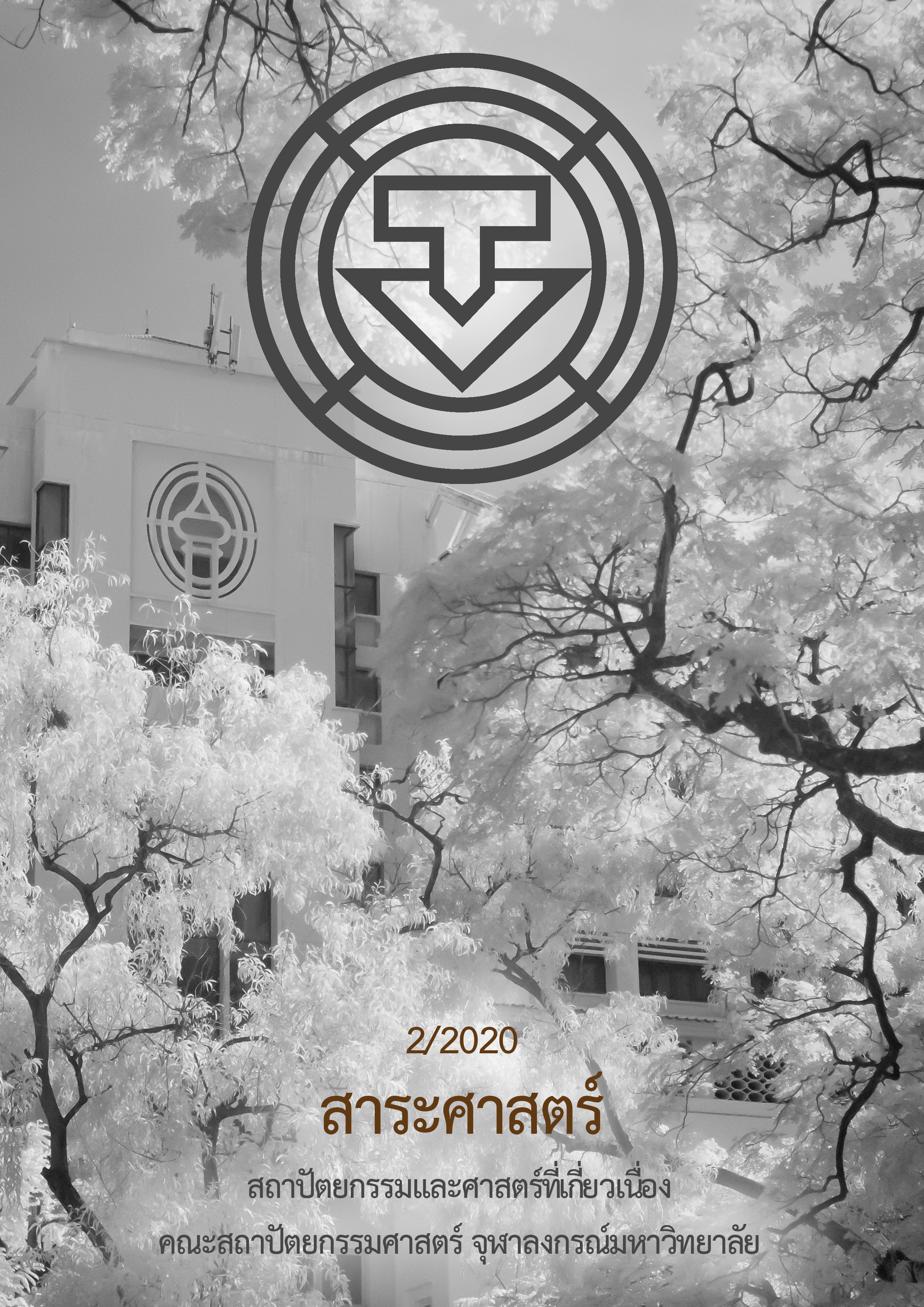การพัฒนาเครื่องมือสำหรับประเมินภูมิทัศน์ในด้านการส่งเสริม ความรู้สึกถึงการฟื้นคืนพลังจากความเหนื่อยล้าทางจิตใจ
Main Article Content
บทคัดย่อ
ในปัจจุบันการศึกษาเกี่ยวกับสภาพแวดล้อมธรรมชาติในฐานะที่มีส่วนในการช่วยฟื้นฟูจิตใจและส่งเสริมสุขภาวะนั้นเป็นที่ยอมรับในแวดวงวิชาการทั้งในประเทศไทยและต่างประเทศ โดยทฤษฎีฟื้นฟูความใส่ใจ (The Attention Restoration Theory: ART) ได้อธิบายถึงคุณสมบัติ 4 ประการของสภาพแวดล้อมที่เอื้อต่อความรู้สึกถึงการฟื้นคืนพลังจากความเหนื่อยล้าทางจิตใจ (restorative environment) ได้แก่ 1) การให้ความรู้สึกห่างจากสิ่งที่หมกมุ่น (being away) 2) การมีสิ่งเร้าที่ดึงดูดความสนใจได้โดยง่าย (fascinating) 3) การรับรู้พื้นที่ทางกายภาพและขอบเขตได้ง่าย (extend) (4) ความเข้ากันได้ระหว่างความต้องการในการฟื้นฟูจิตใจกับสภาพแวดล้อม (compatibility) แต่อย่างไรก็ตามในประเทศไทยยังไม่มีเครื่องมือสำหรับประเมินสภาพแวดล้อมธรรมชาติที่มีคุณสมบัติดังกล่าว ดังนั้น บทความนี้จึงมีวัตถุประสงค์เพื่อนำเสนอการพัฒนาเครื่องมือประเมินภูมิทัศน์ในด้านการส่งเสริมความรู้สึกฟื้นคืนพลังจากความเหนื่อยล้าทางจิตใจ โดยการนำทฤษฎีพื้นฐานและมาตรวัดทางจิตวิทยามาพัฒนาเป็นเครื่องมือในการประเมินคุณสมบัติดังกล่าวของภูมิทัศน์ธรรมชาติจำนวน 3 รูปแบบ (ป่า ทุ่งหญ้า และริมน้ำ) จากนั้นจึงทำการทดสอบเครื่องมือที่พัฒนาขึ้นนี้โดยการเก็บข้อมูลจากนิสิตระดับปริญญาตรีจากหลากหลายคณะจำนวน 70 คน ผลการทดสอบพบว่าแบบประเมินนี้มีความตรงและความเที่ยงอยู่ในเกณฑ์ดี (ภาพภูมิทัศน์แบบป่า ทุ่งหญ้า และริมน้ำ มีค่าความเที่ยงแบบความสอดคล้องภายในด้วยสัมประสิทธิ์แอลฟาของครอนบาค เท่ากับ .88, .89 และ.87 ตามลำดับ) ดังนั้น จึงมุ่งหวังว่าเครื่องมือนี้จะช่วยพัฒนาองค์ความรู้ด้านการออกแบบสภาพแวดล้อมให้สามารถมีส่วนช่วยลดปัญหาสุขภาพจิตในสังคมไทยได้ ทั้งนี้เนื่องจากการศึกษาครั้งนี้ใช้ภาพถ่ายเป็นตัวแทนภูมิทัศน์ธรรมชาติในแต่ละรูปแบบ การศึกษาที่น่าสนใจต่อไปก็คือ การเปรียบเทียบความแตกต่างระหว่างการใช้ภาพถ่ายกับภาพเคลื่อนไหวหรือวิดีทัศน์และภูมิทัศน์จริงเป็นตัวแทนภูมิทัศน์รูปแบบต่าง ๆ
Article Details
เอกสารอ้างอิง
สุพิชฌาย์ เมืองศรี. “แนวทางการปรับปรุงคุณภาพเชิงทัศน์บริเวณมุมมองสำคัญของสถานที่ท่องเที่ยวทางประวัติศาสตร์ในเขตเมืองเชียงใหม่.” วิทยานิพนธ์ปริญญามหาบัณฑิต จุฬาลงกรณ์มหาวิทยาลัย, 2553.
สุวิมล ติรกานันท์. ระเบียบวิธีการวิจัยทางสังคมศาสตร์: แนวทางสู่การปฎิบัติ. กรุงเทพฯ: จุฬาลงกรณ์มหาวิทยาลัย, 2555.
อรัญญา ตุ้ยคำภีร์, จีระสุข สุขสวัสดิ์, จันทนา ยิ้มน้อย, ณัฐนสิน คำสำเภา, ไหมไทย ไชยพันธุ์, ตะวัน วาทะกิจและบุญโรม สุวรรณพาหุ. “การทำสวนและธรรมชาติบำบัด.” วารสารศึกษาศาสตร์ มหาวิทยาทักษิณ (2557): 14, 1-7.
Appleton, J. The Experience of Landscape. New York: John Wiley & Son, 1996.
Berga, A. E. V. D., A., Jorgensenc and E. R., Wilsond. “Evaluating Restoration in Urban Green Spaces: Does Setting Type Make a Difference?” Landscape and Urban Planning 127 (2014): 173–181.
Berga, A. E. V. D., Y., Joyeb and S. L., Koolec. “Why Viewing Nature Is More Fascinating and Restorative than Viewing Buildings: A Closer Look at Perceived Complexity.” Urban Forestry & Urban Greening 20 (2017): 397–401.
Gullone, E. “The Biophilia Hypothesis and Life in the 21st Century: Increasing Mental Health or Increasing Pathology?” Journal of Happiness Studies 1 (2000): 293–321.
Hartig, T., F.G., Kaiser and P.A., Bowler. Further Development of a Measure of Perceived Environmental Restorativeness. Uppsala: Institute for Housing Research, Uppsala Universitet, 1997.
Hartig, T., K., Korpela, G. W., Evans and Tommy, Gärling. “Validation of a Measure of Perceived Environmental Restorativeness.” Göteborg Psychological Reports 26, 7 (1996): 26:1-26:64.
Herzog, T.R., P.M. Colleen and M.B. Nebel. “Assessing the Restorative Components of Environments.” Journal of Environmental Psychology 23, 2 (June 2003): 159-170.
Kaplan, R. and S, Kaplan. The Experience of Nature. Cambridge: Press Syndicate of the University of Cambridge, 1989.
Kaplan, S. “The Restorative Benefits of Nature: Toward an Integrative Framework.” Journal of Environmental Psychology 15 (1995): 169-182.
Kaplan, S. The Restorative Environment: Nature and Human Experience. Portland, OR.: Timber Press, 1992.
Kjellgren, A. and H., Buhrkall. “A Comparison of the Restorative Effect of a Natural Environment with That of a Simulated Natural Environment.” Journal of Environmental Psychology 30 (2010): 464–472.
Muhamad S. F. R., R. A. R., Syumi and H, Lamit. “Biophilia Theory Revisited: Experts and Non-Experts Perception on Aesthetic Quality of Ecological.” Landscape Social and Behavioral Sciences 153 (2014): 349 – 362.
Rosley, M.S.F., R.A.R. Syumi and H., Lamit. “Biophilia Theory Revisited: Experts and Non-Experts Perception on Aesthetic Quality of Ecological Landscape.” Procedia-Social and Behavioral Sciences 153 (16 October 2014): 349-362.
Simonic, T. “Urban Landscape as a Restorative Environment: Preferences and Design Considerations.” Acta Agriculturae Slovenica 87 (2006): 325-332.
Smardon, R. C., J. F., Palmer and J. P., Felleman. Foundations for Visual Project Analysis. Hoboken, NJ.: John Wiley Sons, 1986.
Staatsa, H., A., Kievieta and T., Hartig. “Where to Recover from Attentional Fatigue: An Expectancy-Value Analysis of Environmental Preference.” Journal of Environmental Psychology 23 (2003): 147–157.
Thomas R. H., P. M., Colleen and M. B., Nebel. “Assessing the Restorative Components of Environments.” Journal of Environmental Psychology 23 (2003): 159–170.
Twedt, E., R. M., Rainey and D. R., Proffitt. “Beyond Nature: The Roles of Visual Appeal and Individual Differences in Perceived Restorative Potential.” Journal of Environmental Psychology 65, 33 (October 2019): 101322.


